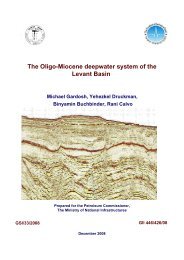tivity on the carmel faul
tivity on the carmel faul
tivity on the carmel faul
Create successful ePaper yourself
Turn your PDF publications into a flip-book with our unique Google optimized e-Paper software.
The sample age cluster of ca. 137ka may possibly be supported by <strong>the</strong> age obtained<br />
for a post collapse growth <strong>on</strong> a ceiling block, dated in Har-Tuv cave to be younger than<br />
135ka (Kagan, 2002).<br />
The age cluster of ca. 148ka was obtained from <strong>on</strong>ly four dated samples.<br />
Never<strong>the</strong>less, it is corroborated by dated speleo<strong>the</strong>m samples from Har-Tuv and Soreq<br />
caves, which yielded ages between 144 and 155ka (Kagan, 2002). It might also be<br />
corroborated by <strong>the</strong> age of material from <strong>the</strong> base of <strong>the</strong> shutter ridge studied by Zilberman<br />
et al. (2006), which was dated to 146±20ka. It should be noted that <strong>the</strong> error margin for that<br />
age is much larger than that of <strong>the</strong> age cluster from Denya Cave (147.6±5.4).<br />
Although <strong>the</strong> age cluster that was determined by Denya Cave seismite samples at<br />
160±45 has a large error, it might never<strong>the</strong>less be compared to <strong>the</strong> age, reported by<br />
Zilberman et al. (2006), for a layer in a paleoseismic trench, which indicated subsidence of<br />
a small basin south of <strong>the</strong> main <strong>faul</strong>t, and was dated to 176±30ka. A collapsed pillar in<br />
Soreq cave yielded a post-seismic age of ca. 163ka, and might also be compared to this age<br />
cluster.<br />
Ages obtained for Denya Cave age clusters can potentially be compared to o<strong>the</strong>r ages<br />
from paleoseismological findings in Israel. The likelihood that this correlati<strong>on</strong> is random<br />
can be estimated by randomly picking age ranges from <strong>the</strong> interval of <strong>the</strong> entire record,<br />
namely 0-206 ka. Each of <strong>the</strong> Denya Cave dated events cumulatively occupy a finite time<br />
range, and <strong>the</strong> chance for it to correlate at random with <strong>the</strong> time occupied by o<strong>the</strong>r records<br />
is given by <strong>the</strong> ratio between <strong>the</strong> latter (total=149.9ky) and <strong>the</strong> range of dated time<br />
(204.1ky). Each separate event dated by Denya Cave speleo-seismites has a ~70% chance<br />
of randomly correlating to <strong>on</strong>e of <strong>the</strong> o<strong>the</strong>r ages dated by different studies. For all nine<br />
dated events to correlate, this figure needs to be raised by <strong>the</strong> power of nine events recorded<br />
in Denya Cave (i.e. {[149.9/204.1]^9}*100), giving a ~6% chance. Those numbers<br />
c<strong>on</strong>sider <strong>the</strong> errors <strong>on</strong> <strong>the</strong> given ages, which are higher for most of <strong>the</strong> ages older than<br />
100ka. The same estimati<strong>on</strong> was d<strong>on</strong>e for <strong>the</strong> likelihood that <strong>the</strong> six age clusters, which<br />
yielded younger ages than 100ka, dated from Denya Cave speleo-seismites could all<br />
randomly be correlated to o<strong>the</strong>r dated seismic events. It was found that for <strong>the</strong>re is a ~3%<br />
chance of that to happen (i.e. {[49.9(time occupied by o<strong>the</strong>r dated events)/88.1(<strong>the</strong> range of<br />
dated events)]^6}*100).<br />
These results fur<strong>the</strong>r enforce that age clusters obtained from Denya Cave speleoseismites<br />
are not random, and are indicators of seismic events. This comparis<strong>on</strong> also<br />
74

















